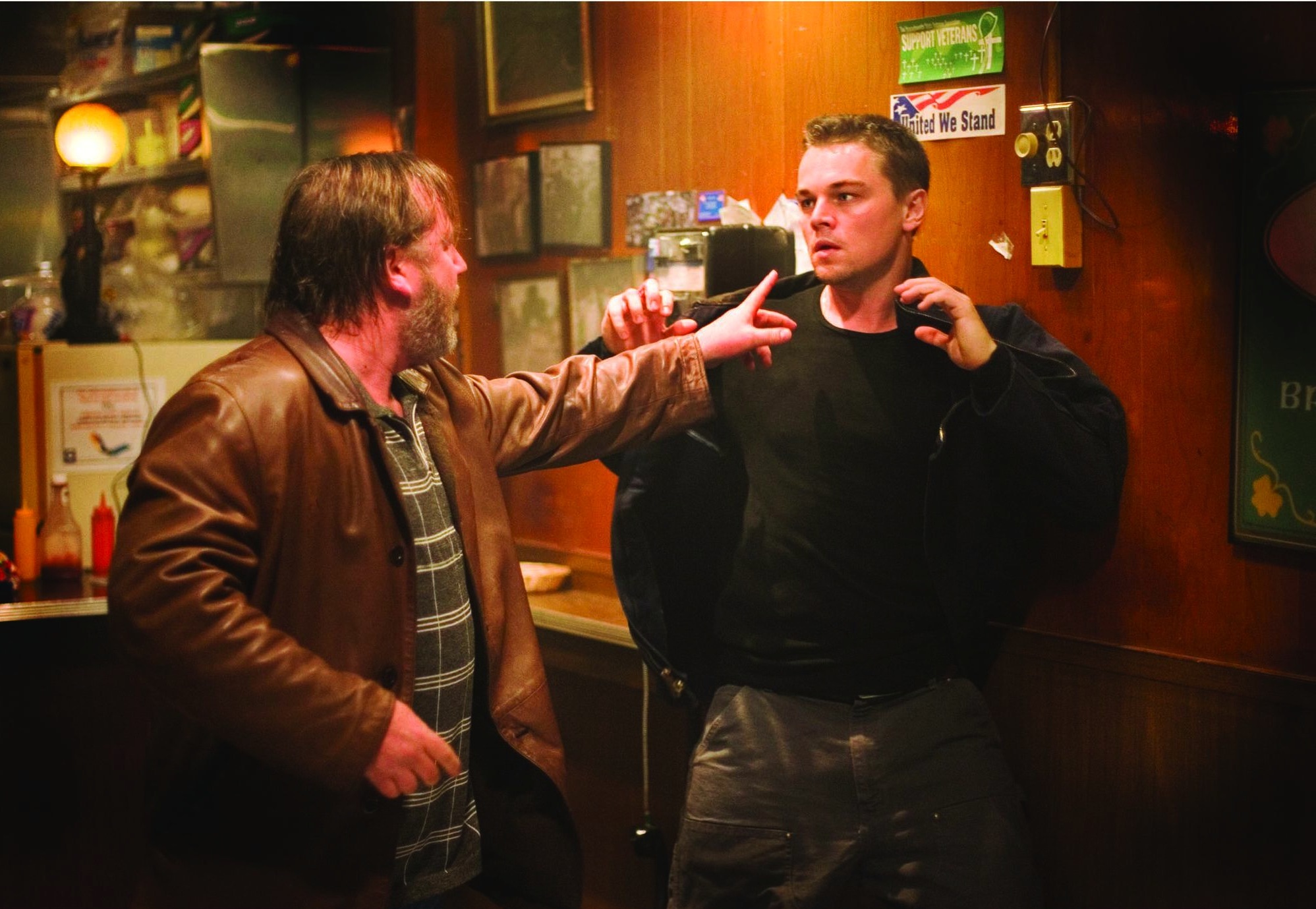In the gritty underworld of Boston crime, identity becomes the most dangerous weapon and the most vulnerable target. Martin Scorsese’s “The Departed” (2006) masterfully explores this precarious balance through an intricate cat-and-mouse game that elevates the crime thriller genre to high art. The film, which finally earned Scorsese his long-overdue Academy Award for Best Director, weaves a complex narrative of two men living double lives on opposite sides of the law. With its stellar ensemble cast, razor-sharp screenplay, and unflinching examination of moral corruption, “The Departed” stands as one of the most compelling crime dramas of the 21st century. Far from a simple cops-and-robbers tale, this psychological thriller delves deep into questions of identity, loyalty, and the corrupting influence of power, delivering a cinematic experience that remains as shocking and relevant today as it was upon its release.
Quick Summary Box
| Category | Details |
|---|---|
| Movie Name | The Departed (2006) |
| Director | Martin Scorsese |
| Cast | Leonardo DiCaprio, Matt Damon, Jack Nicholson, Mark Wahlberg, Martin Sheen, Vera Farmiga |
| Genre | Crime, Drama, Thriller |
| IMDb Rating | 8.5/10 ⭐ |
| Duration | 2h 31m |
| Where to Watch | HBO Max, Amazon Prime (rental), Apple TV (rental) |
| Release Date | October 6, 2006 |
A Dance of Deceit: Plot Overview
“The Departed” centers on a dangerous game of infiltration and counter-infiltration between the Massachusetts State Police and an Irish-American organized crime syndicate led by the ruthless Frank Costello (Jack Nicholson). When the police department plants undercover officer Billy Costigan (Leonardo DiCaprio) within Costello’s crew, they’re unaware that Costello has simultaneously positioned his own mole, Colin Sullivan (Matt Damon), within the police department. As these mirror-image informants work to expose each other, their parallel lives begin to intersect in unexpected and increasingly dangerous ways.
What ensues is a masterclass in escalating tension, as both men struggle to maintain their cover while hunting down their counterpart. The stakes rise exponentially when both become involved with police psychiatrist Madolyn Madden (Vera Farmiga), creating a love triangle that threatens to expose them both. As the walls close in, both men must confront questions of who they’ve become after years of living as someone else, leading to a cascade of violence and betrayal that leaves no character unscathed.
Character Complexity: Performances That Define Careers
Leonardo DiCaprio delivers one of his most nuanced performances as Billy Costigan, the undercover officer forced to embrace a criminal persona that increasingly threatens to consume him. DiCaprio expertly portrays a man fragmenting under pressure, his psychological deterioration manifesting in subtle tics, paranoid glances, and explosive outbursts. The actor conveys Costigan’s growing isolation and moral confusion with remarkable restraint, making his occasional violent eruptions all the more impactful.
In perfect counterpoint, Matt Damon’s Colin Sullivan presents a study in calculated composure that gradually fractures throughout the film. Damon excels at portraying Sullivan’s chameleon-like ability to present different faces to different people while maintaining an outward appearance of unflappable confidence. The actor’s greatest achievement is how he subtly reveals the emptiness beneath Sullivan’s perfect façade—the toll of a lifetime of deception visible only in fleeting moments of vulnerability.
Jack Nicholson delivers a performance of operatic malevolence as Frank Costello, creating a crime boss whose charm is as terrifying as his cruelty. Rather than relying on gangster film clichés, Nicholson crafts a unique villain whose unpredictability makes every scene he occupies crackle with menace. His Costello is a monster who views manipulation as art form—a sociopath who genuinely believes his worldview represents wisdom rather than pathology.
The supporting cast deserves equal recognition, particularly Mark Wahlberg’s scene-stealing turn as foul-mouthed, aggressively competent Sergeant Dignam. Wahlberg earned an Oscar nomination for creating a character whose hostility masks a fierce moral code. Martin Sheen brings warmth and integrity to Captain Queenan, while Alec Baldwin balances humor and hardness as Captain Ellerby. Vera Farmiga handles the challenging role of Madolyn with intelligence and emotional depth, creating a fully realized character despite being the only significant female presence in an overwhelmingly masculine narrative.
Scorsese’s Signature: Direction, Editing, and Visual Style

Martin Scorsese’s direction of “The Departed” represents a filmmaker at the height of his powers, combining the energetic stylistic flourishes of his early work with the mature restraint of his later career. His camera work remains dynamic and expressive without ever becoming showy or distracting from the narrative. Particularly effective is his use of surveillance imagery throughout the film, visually reinforcing themes of watching and being watched, of seeing versus being seen.
Working with longtime collaborator Thelma Schoonmaker, Scorsese crafts an editing rhythm that miraculously maintains clarity despite the film’s complex parallel storylines. The frequent cross-cutting between DiCaprio and Damon’s characters creates a visual dialogue between their mirrored lives, while the occasional shocking burst of violence follows Scorsese’s trademark approach of maximum impact through minimal preparation.
Cinematographer Michael Ballhaus bathes the film in a distinctive visual palette that contrasts the sterile, fluorescent-lit world of police bureaucracy with the shadowy, amber-tinted domain of Costello’s criminal enterprise. Boston itself becomes a character through Ballhaus’s lens, its working-class neighborhoods, sterile high-rises, and historic architecture forming a textured backdrop for the moral decay unfolding within its boundaries.
Production designer Kristi Zea deserves special recognition for the subtle ways environment reflects character—from Sullivan’s sleek, impersonal luxury apartment (all surface, no substance) to Costigan’s sparse, temporary-feeling living spaces that mirror his transient identity. These visual cues enrich our understanding of characters beyond dialogue and action.
A Soundtrack of Tension and Identity
The musical landscape of “The Departed” contributes significantly to its atmospheric power, beginning with the inspired use of The Dropkick Murphys’ “I’m Shipping Up to Boston” during the opening montage—a perfect establishment of cultural setting and energetic tone. Howard Shore’s original score provides subtle emotional underpinning rather than obvious melodramatic cues, allowing the performances to carry the emotional weight.
Most innovative is Scorsese’s strategic deployment of cellular phone ringtones as a narrative device. The distinctive rings become anxiety-triggering motifs that signal imminent danger or revelation—a modern updating of the musical leitmotif for the digital age. This technique transforms everyday technology into instruments of escalating tension, particularly effective in a film so concerned with communication, surveillance, and betrayal.
The sound design deserves equal praise for its contribution to the film’s immersive realism, particularly in the violence that punctuates the narrative. Gunshots arrive with shocking suddenness and authentic impact, never stylized or sanitized, reinforcing the film’s unflinching portrayal of violence and its consequences.
Thematic Richness: Identity and Moral Corruption
At its core, “The Departed” is an exploration of how identity is shaped, fragmented, and potentially destroyed by the roles we play. Both protagonists begin with clear missions but gradually lose themselves in their fabricated personas, raising profound questions about the nature of authentic self. Sullivan, who has spent his entire adult life as someone else, increasingly seems hollow beneath his perfect exterior, while Costigan’s immersion in criminality threatens to erase the moral foundations that once defined him.
The film also offers a nuanced examination of father-son dynamics and masculine identity. Costello functions as a twisted father figure to both protagonists—directly mentoring Sullivan from childhood while representing the criminal archetype Costigan must emulate. This patriarchal influence proves corrosive to both men, suggesting that toxic masculinity reproduces itself generationally through models of power, violence, and emotional repression.
Institutional corruption forms another key theme, with the film suggesting that the line between criminal organization and law enforcement can become dangerously blurred. Both institutions demand absolute loyalty while harboring internal betrayal, and both claim moral righteousness while committing acts of brutality. This systemic critique gives the film’s personal dramas broader sociopolitical resonance.
Religion and morality weave through the narrative in complex ways, from the prominently Catholic cultural backdrop of Boston to Costello’s nihilistic monologues directly challenging religious authority. The film presents a moral universe where traditional ethical frameworks prove inadequate for navigating a world of profound moral compromises.
Strengths and Challenges: A Critical Assessment
“The Departed” excels in its character development and the mounting psychological tension between its parallel protagonists. The screenplay by William Monahan (adapted from the Hong Kong film “Infernal Affairs”) balances intricate plotting with moments of surprising humor and philosophical depth. Dialogue crackles with authenticity and regional specificity, creating characters who feel genuinely rooted in Boston’s unique cultural landscape.
The film’s greatest strength may be how it subverts audience expectations around narrative justice and closure. Without revealing specific plot developments, “The Departed” consistently refuses to follow conventional patterns of crime-genre storytelling, creating a viewing experience that remains unpredictable even for audiences familiar with the genre’s typical trajectories.
If the film has weaknesses, they may lie in its treatment of female characters, with Farmiga’s Madolyn representing virtually the only significant female presence. While her character receives more dimension than typical crime-film love interests, the film’s perspective remains overwhelmingly masculine, reflecting the male-dominated worlds it portrays without necessarily critiquing that dominance.
Some critics have also questioned whether the film’s final act relies too heavily on coincidence to bring its complex narrative strands together. However, these moments might also be interpreted as the inevitable collision of two worlds that could not remain separate indefinitely—a thematic reinforcement rather than a narrative convenience.
Comparison to Scorsese’s Crime Film Legacy
“The Departed” exists in fascinating dialogue with Scorsese’s earlier crime films while establishing its own distinct identity. Unlike the nostalgic, almost mythological portrayal of organized crime in “Goodfellas” or the operatic rise-and-fall narrative of “Casino,” “The Departed” presents a colder, more contemporary vision of criminality. Costello’s crew lacks the twisted brotherhood of earlier Scorsese gangsters, operating instead as a paranoid enterprise where loyalty extends only as far as utility.
Where “Mean Streets” and “Goodfellas” traced the allure and subsequent disillusionment with criminal life, “The Departed” begins with disillusionment already established. Its characters inhabit a post-romantic crime world where neither law enforcement nor organized crime offers clear moral high ground or authentic community.
The film shares with “Taxi Driver” and “Raging Bull” a fascination with masculine identity in crisis, but replaces those films’ exploration of outsider psychology with an examination of institutional power and the psychological toll of deception. In this sense, “The Departed” represents an evolution in Scorsese’s thematic concerns while maintaining his signature intense character focus and visual dynamism.
Conclusion: A Modern Crime Classic
“The Departed” stands as a towering achievement in contemporary American cinema and one of Martin Scorsese’s defining masterworks. Through its intricate narrative construction, phenomenal ensemble performances, and thematic complexity, the film transcends the limitations of the crime thriller genre to offer profound insights into identity, morality, and institutional corruption.
What makes the film particularly remarkable is how it balances intellectual depth with visceral entertainment. Audiences can appreciate its psychological nuances and social commentary while simultaneously enjoying its propulsive plotting and moments of shocking violence. This dual appeal helps explain the film’s success with both critics and general audiences, earning both Academy recognition and lasting cultural relevance.
For viewers seeking thoughtful, adult-oriented cinema that challenges and entertains in equal measure, “The Departed” offers a rich, rewarding experience that reveals new layers with each viewing. Its influence on subsequent crime dramas remains evident, but few have matched its perfect balance of character depth, narrative complexity, and directorial virtuosity.
Rating: ★★★★★ (5/5 stars)
Where to Watch The Departed
“The Departed” is currently available for streaming on HBO Max. For those without a subscription, the film can be rented or purchased digitally through platforms like Amazon Prime Video, Apple TV, Google Play, and Vudu. Occasionally, the film appears in repertory theaters or as part of Scorsese retrospectives, offering viewers the chance to experience its visual power on the big screen.
If You Enjoyed “The Departed Review,” You Might Also Like:
- The Irishman (2019) Review
- Goodfellas (1990) Review
- No Country for Old Men (2007) Review
- Casino (1995) Review
